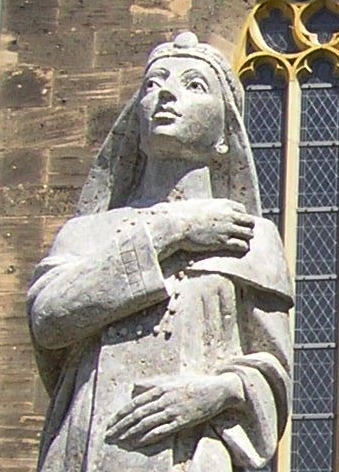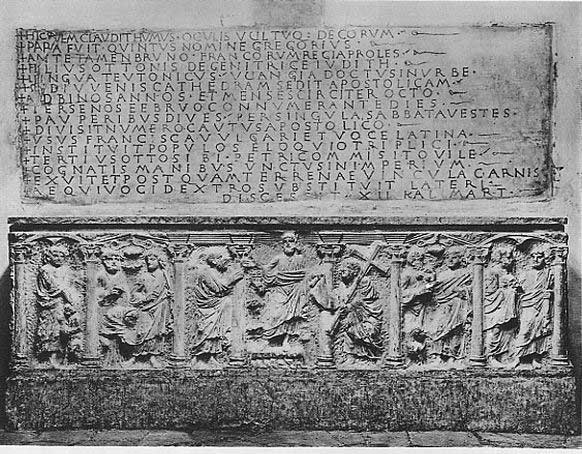|
Amizo (bishop Of Turin)
Amizo of Turin (died 1000) was an Italian bishop. He was bishop of Turin from 966 until his death in 1000. Based on an early modern Milanese chronicle, it is sometimes argued that Amizo was the son of Arduin Glaber of Turin. Sometime between 983 and 987, Amizo consecrated abbey of Sacra di San Michele, founded by Hugh of Montboissier. In 989 Amizo granted the parish of S. Maria di Quadraciana to the nuns at San Pietro in Turin, enriching them with property at Scarnafigi and Cervignasco. Amizo obtained two imperial diplomas confirming the church of Turin in all its possessions: the first was issued by Otto II in 981, and the second by Otto III in 998. In 997 Amizo participated in the synod of Pavia, presided over by Pope Gregory V Pope Gregory V (; c. 972 – 18 February 999), born Bruno of Carinthia, was the bishop of Rome and ruler of the Papal States from 3 May 996 to his death. A member of the Salian dynasty, he was made pope by his cousin, Emperor Otto III. Family ....Sa ... [...More Info...] [...Related Items...] OR: [Wikipedia] [Google] [Baidu] |
Roman Catholic Archdiocese Of Turin
The Archdiocese of Turin () is a Latin Church ecclesiastical territory of the Catholic Church in Italy."Archdiocese of Torino " '' Catholic-Hierarchy.org''. David M. Cheney. Retrieved January 4, 2017."Metropolitan Archdiocese of Torino" ''GCatholic.org''. Gabriel Chow. Retrieved February 29, 2016. The diocese of Turin was founded in the 4th century and elevated to the dignity of an on 21 May 1515 by < ... [...More Info...] [...Related Items...] OR: [Wikipedia] [Google] [Baidu] |
Arduin Glaber
Arduin Glaber (,'' Glabrione'', or'' il Glabro'', meaning "the Bald"; died c. 977) was count of Auriate from c. 935, count of Turin from c. 941/942, and Margrave of Turin from c. 950/964. He placed his dynasty, the Arduinici, on a firm foundation and established the march of Turin through conquests and royal concessions. The '' Chronicon Novaliciense'', the chronicle of the abbey of Novalesa, is the primary source for his life.M. G. Bertolini, "Arduino", ''Dizionario biografico degli Italiani'', VI (Rome: Società Grafica Romana, 1964), 49–52. Biography Arduin was the eldest son of Roger, Count of Auriate (r. c. 906 – c. 935), a Frankish nobleman who immigrated to Italy in the early tenth century. The medieval county of Auriate comprised the region bounded by the Alps, the Po River, and the Stura, today the regions of the Saluzzese and Cuneese. Arduin succeeded his father as count of Auriate sometime around 935, but he is not documented as Count Arduin (''Ardoino co ... [...More Info...] [...Related Items...] OR: [Wikipedia] [Google] [Baidu] |
Sacra Di San Michele
The Sacra di San Michele, sometimes known as Saint Michael's Abbey, is a religious complex on Mount Pirchiriano, situated on the south side of the Val di Susa in the territory of the municipality of Sant'Ambrogio di Torino, in the Metropolitan City of Turin, Piedmont region of northwestern Italy. The abbey, which for much of its history was under Benedictine rule, is now entrusted to the Rosminians. A special regional law acknowledges it as the "Symbolic monument of the Piedmont region". This monumental abbey served as one of the inspirations for the book '' The Name of the Rose'' by Umberto Eco. History According to some historians, in Roman times a military stronghold existed on the current location of the abbey, commanding the main road leading to Gaul from Italy. Later, after the fall of the Western Roman Empire, the Lombards built a fortress here against the Frankish invasions. Little is known of the early years of the abbey. The oldest extant account is that of a monk ... [...More Info...] [...Related Items...] OR: [Wikipedia] [Google] [Baidu] |
Otto II, Holy Roman Emperor
Otto II (955 – 7 December 983), called the Red (), was Holy Roman Emperor from 973 until his death in 983. A member of the Ottonian dynasty, Otto II was the youngest and sole surviving son of Otto the Great and Adelaide of Italy. Otto II was made joint-ruler of Germany in 961, at an early age, and his father named him co-Emperor in 967 to secure his succession to the throne. His father also arranged for Otto II to marry the Byzantine Empire, Byzantine Princess Theophanu, who would be his wife until his death. When his father died after a 37-year reign, the eighteen-year-old Otto II became Autocracy, absolute ruler of the Holy Roman Empire in a peaceful succession. Otto II spent his reign continuing his father's policy of strengthening Imperial rule in Germany and extending the borders of the Empire deeper into Southern Italy. Otto II also continued the work of Otto I in subordinating the Catholic Church to Imperial control. Early in his reign, Otto II defeated a War of the Th ... [...More Info...] [...Related Items...] OR: [Wikipedia] [Google] [Baidu] |
Otto III, Holy Roman Emperor
Otto III (June/July 980 – 23 January 1002) was the Holy Roman emperor and King of Italy from 996 until his death in 1002. A member of the Ottonian dynasty, Otto III was the only son of Emperor Otto II and his wife Theophanu. Otto III was crowned as king of Germany in 983 at the age of three, shortly after his father's death in Southern Italy while campaigning against the Byzantine Empire and the Emirate of Sicily. Though the nominal ruler of Germany, Otto III's minor status ensured his various regents held power over the Empire. His cousin Duke Henry II of Bavaria, initially claimed regency over the young king and attempted to seize the throne for himself in 984. When his rebellion failed to gain the support of Germany's aristocracy, Henry II was forced to abandon his claims to the throne and to allow Otto III's mother Theophanu to serve as regent until her death in 991. Otto III was then still a child, so his grandmother, Adelaide of Italy, served as regent until 994. In 996 ... [...More Info...] [...Related Items...] OR: [Wikipedia] [Google] [Baidu] |
Pope Gregory V
Pope Gregory V (; c. 972 – 18 February 999), born Bruno of Carinthia, was the bishop of Rome and ruler of the Papal States from 3 May 996 to his death. A member of the Salian dynasty, he was made pope by his cousin, Emperor Otto III. Family Bruno was a son of Otto I, Duke of Carinthia, a member of the Salian dynasty who was a grandson of Otto I, Holy Roman Emperor, and his wife, Judith of Carinthia, most likely a member of the Luitpolding dynasty. He is the only pope who was born in modern Austria, and is sometimes referred to as "the first German pope" or as "the only Austrian pope;" German and Austrian identity was not formed at the time of Gregory's life. Papal election Bruno was the chaplain of his cousin, Emperor Otto III, who presented him as a candidate and arranged his election. Bruno was elected and succeeded John XV as pope, taking the name Gregory V to honour Pope Gregory the Great; he thus became the first pope to choose a regnal name for a reason other than ... [...More Info...] [...Related Items...] OR: [Wikipedia] [Google] [Baidu] |
Gezo (bishop Of Turin)
Gezo of Turin (died 1011) was an Italian bishop. He was bishop of Turin from 1000 until his death in 1011. In 1006 Gezo founded the monastery of San Solutore in Turin, which was dedicated to saints Solutor, Octavius and Adventor, who were the patrons of the city of Turin. Also in 1006 Gezo was present – at the request of Pope John XVIII Pope John XVIII (; died June or July 1009) was the bishop of Rome and nominal ruler of the Papal States from January 1004 (25 December 1003 NS) to his abdication in July 1009. He wielded little temporal power, ruling during the struggle betwee ... – at the consecration of the Abbey of Fruttuaria, alongside other bishops from the region.Bulst, ''Untersuchungen zu den Klosterreformen'', p. 118 References *F. Savio, ''Gli antichi vescovi d’Italia. Il Piemonte'' (Turin, 1899), pp. 335–339. * N. Bulst, ''Untersuchungen zu den Klosterreformen Wilhelm von Dijon (962-1031)'' (Bonn 1973). Notes 11th-century Italian Roman C ... [...More Info...] [...Related Items...] OR: [Wikipedia] [Google] [Baidu] |
Bishops Of Turin
The Archdiocese of Turin () is a Latin Church ecclesiastical territory of the Catholic Church in Italy."Archdiocese of Torino " ''''. David M. Cheney. Retrieved January 4, 2017."Metropolitan Archdiocese of Torino" ''GCatholic.org''. Gabriel Chow. Retrieved February 29, 2016. The diocese of Turin was founded in the 4th century and elevated to the dignity of an |
10th-century Italian Bishops
1 (one, unit, unity) is a number, numeral, and glyph. It is the first and smallest positive integer of the infinite sequence of natural numbers. This fundamental property has led to its unique uses in other fields, ranging from science to sports, where it commonly denotes the first, leading, or top thing in a group. 1 is the unit of counting or measurement, a determiner for singular nouns, and a gender-neutral pronoun. Historically, the representation of 1 evolved from ancient Sumerian and Babylonian symbols to the modern Arabic numeral. In mathematics, 1 is the multiplicative identity, meaning that any number multiplied by 1 equals the same number. 1 is by convention not considered a prime number. In digital technology, 1 represents the "on" state in binary code, the foundation of computing. Philosophically, 1 symbolizes the ultimate reality or source of existence in various traditions. In mathematics The number 1 is the first natural number after 0. Each natural number, ... [...More Info...] [...Related Items...] OR: [Wikipedia] [Google] [Baidu] |



